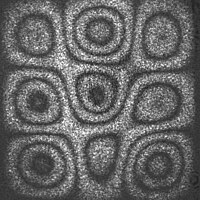
Photo from wikipedia
Many different approaches to formulate thermodiffusion theories in 3D bodies have been developed in the literature, see the historical review [4]. In engineering applications to shell structures one needs a… Click to show full abstract
Many different approaches to formulate thermodiffusion theories in 3D bodies have been developed in the literature, see the historical review [4]. In engineering applications to shell structures one needs a 2D model of thermodiffusion based on laws of 3D continuum thermodynamics [5,7]. Among many important phenomena in shells to be described by such a 2D model is, for example, the transient hydrogen and heat diffusion. It embrittles the materials of shell structures used for hydrogen production, storage and distribution and significantly affects the behaviour of the structures. Another example is the moisture sorption in shell structures made of polymeric materials and composites which may considerably change the prediction of moisture transport processes in shells. To formulate the 2D model of shell thermodiffusion we apply the direct through-the-thickness integration [1–3] of 3D laws of continuum thermodiffusion [5,7].
Journal Title: Continuum Mechanics and Thermodynamics
Year Published: 2020
Link to full text (if available)
Share on Social Media: Sign Up to like & get
recommendations!